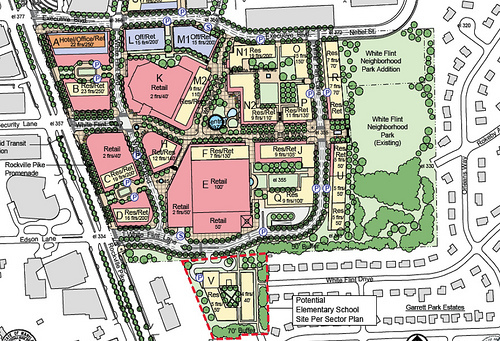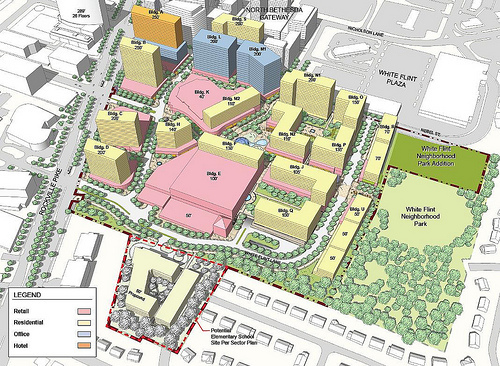White Flint’s journey points way for other struggling malls
White Flint Mall opened in 1977 as the emblem of Montgomery County’s rising suburban affluence, but over time the luxury mall began to show its age. Now located at the center of the urbanizing White Flint Sector Plan area, the mall’s transformation into an urban neighborhood is a sign of where the county’s going.
“It’s going to be an incredible project, certainly adding to the energy and synergy of White Flint,” says Francine Waters, managing director of owner Lerner Enterprises, which built the mall and others like it throughout the region over the past several decades.
In October, the Planning Board approved a sketch plan to replace the 874,000-square-foot mall and an adjacent office building with 5.2 million square feet of shops, homes, offices and a hotel. The project could take 25 years to build over 3 phases; when finished, it would be the largest development in the White Flint area.
In a 2011 Washington Post article, Michael Cohen of Boston-based Elkus Manfredi Architects described the project as “making a town, a community.”
Enclosed malls like White Flint were popular throughout North America during the late 20th century, but have become less popular as changing demographics and shopping habits have lured consumers to big-box stores and the Internet.
Borders, one of the mall’s anchors, filed for bankruptcy and closed in 2011, followed by Bloomingdale’s, which closed last year and moved to the mixed-use Wisconsin Place complex in Friendship Heights. Though Lerner won’t divulge how many vacancies there are, portions of the mall are now empty.
What can you do to refresh a mall? Some, like Landover Mall in Prince George’s County, were simply demolished while awaiting another use, while others like Harundale Mall in Anne Arundel County were turned into a strip center. A few, however, are being turned into something that resembles a neighborhood, with a mix of residential and commercial uses and public open space.
One of the best examples of this kind of redevelopment is Belmar, a former mall outside of Denver that is being redeveloped as a suburban downtown. Closer to home, plans are underway to do the same with Landmark Mall in Alexandria and Owings Mills Mall in Baltimore County.
To orchestrate this transformation, Lerner hired Elkus Manfredi, which also designed CityPlace in West Palm Beach, Florida, a renowned example of New Urbanist planning principles, and Americana at Brand, a mixed-use project in Glendale, California. Both projects helped revive formerly struggling business districts and became regional destinations.
“We’re looking for that exciting compelling story that [the Friends of White Flint and the White Flint Partnership] all have been looking for,” says Waters. “Elkus Manfredi is a world-class architect and Americana at Brand certainly reflects a very successful project.”
In the proposed design, both department store spaces — Lord and Taylor and the former Bloomingdale’s — would remain, effectively preserving the “memory” of the mall’s original footprint. Meanwhile, the center of the mall would be demolished and replaced by a 1.7-acre “central piazza” surrounded by smaller shops with housing above.
The tallest buildings, reaching as high as 200 to 250 feet, would line Rockville Pike and a future extension of Executive Boulevard that would form the site’s northern boundary. From there, the height steps down to 100-foot-tall buildings around the piazza and 50-foot buildings on the site’s eastern and southern boundaries, where it’s closest to single-family homes.
Overall, there would be 1 million square feet of retail space, which would be joined by another million square feet of office space, a 280,000-square-foot hotel, and over 2400 apartments in 14 buildings. Underground parking garages containing 9,300 spaces would serve the entire development. According to the planning department’s report, each building will be designed and oriented to take advantage of passive solar heating and lighting, reducing energy costs.
A new grid of private streets would divide the site into blocks and connect it to Rockville Pike and future extensions of Executive Boulevard and Nebel Street. The streets will be designed to accommodate pedestrians, bicyclists and cars and have extensive landscaping and street furniture.
Meanwhile, 40% of the site would be set aside as public or private open space, including the piazza, a 2.3-acre addition to the existing White Flint Park, and four smaller plazas scattered throughout the development.
Lerner will also set aside 4 acres on the property’s southern end for an elementary school if Montgomery County Public Schools chooses to purchase it. County planners estimate that the 14,000 housing units that could eventually be built in White Flint will create demand for new schools in the area.
However, there was a brief conflict last fall when the Planning Board asked the developer to simply give the land away, but they later backed down. At the time, Planning Board Chair Francoise Carrier argued that the school was necessary to placate concerns about overcrowded classrooms.
Handing over the property “was not in the sector plan,” says Waters.
While the redevelopment of White Flint Mall has a lot of potential, some urban design issues stem from its history as a mall. While streets break the site up into city blocks, they are much larger than blocks in other projects in the White Flint Sector Plan area. For instance, the block containing the former Bloomingdale’s appears to be over 800 feet long, while the 2 blocks closest to Rockville Pike are subdivided by what appear to be cul-de-sacs that don’t connect to the Pike itself.
Not only does this reduce pedestrian connectivity, but it forces drivers onto a series of 4- and 6-lane streets roughly located where the mall’s ring road is today.
These larger blocks and road sections may arise in part from county Department of Transportation regulations that discourage blocks shorter than 600 feet. While a series of pedestrian passages cutting through the site help improve connectivity, it may be worth reconsidering how the street grid is set up, and whether traffic can be managed with a more fine-grained grid of smaller streets and shorter blocks.
Though the mall is set to close next year, it’s unclear when construction will begin. The Planning Board will need to approve a preliminary plan and a site plan, both of which are more detailed than a sketch plan, before anything can happen. Nonetheless, Waters looks forward to what the property will become.
“It’s going to be an incredible project certainly adding to the energy and synergy of White Flint,” says Waters. “I am absolutely, positively thrilled with what we’re proposing and how it works with the other projects within White Flint.”
This content was originally developed for the Friends of White Flint blog. For more images of White Flint Mall and its proposed redevelopment, check out this slideshow.




